Dear Friends of Bridges to/from Cuba:
First of all, we want to thank all of you who contacted us about your enthusiasm for our project. We were moved that several of you wrote to us within moments after we launched our site on June 8th. It was thrilling to hear that Cubans on the island and beyond, as well as many who aren’t Cuban but care deeply about Cuba, feel we are moving in a positive direction by calling for bridges and the lifting of the emotional embargo. We were touched that several of you offered your support and want to volunteer to help us.
Read post in Spanish >>
We didn’t respond sooner because the site launched just as we were preparing for our trip to Cuba. For years Richard and I had talked about traveling to Cuba together. Finally the time seemed right. On June 13th, we met up at the airport in Miami. We were told to arrive five hours before our departure time. That turned out to be good advice. Several flights were leaving for Havana at the same time, and after we checked in, the lines got so long they snaked all the way down to the front door of the airport. In May, we would have seen Art Biennial types flocking to make the journey to Havana. But mid-June is the start of the low tourist season in Cuba. It starts to get much too hot on the island for foreigners. Our flight was filled only with Cubans bringing gifts for their families, plus the two of us, eager to share each other’s Cuba.

Richard had traveled to Cuba in the past with his mother, while I had mostly traveled on my own, going a couple of times with my husband and son, but never with my parents, who still haven’t wanted to return. We knew it was going to be emotional going together. If you’ve been to Cuba, you know that one day in Cuba is equivalent to about ten days anywhere else in the world. Life is lived with a unique intensity on the island that is indescribable.
In Havana, we stayed in a rental apartment in the building where I lived as a child, which is half a block away from the Patronato Synagogue. The apartment is managed by our former neighbors, who proudly pointed out that our shower had automatic hot and cold running water and so we wouldn’t have to warm up water on the stove and take bucket showers, as most people do in Cuba. As soon as we got settled in, we took a long walk around Vedado, ablaze with bright orange flamboyanes at this time of year. I showed Richard the park where I played as a child, which has a gazebo that has remained unchanged over the years.
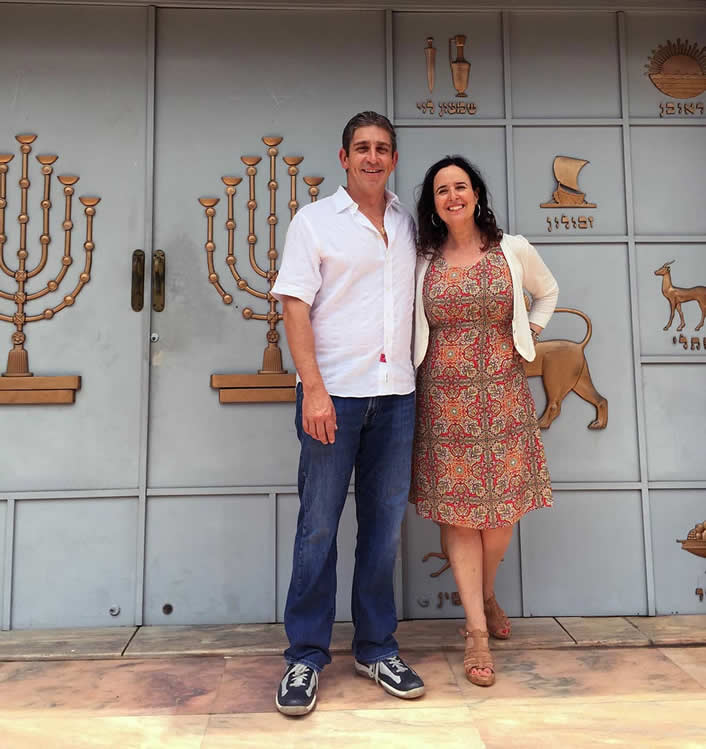
The next day, accompanied by a historian-friend, Gerardo, and his wife, Amarilys, we took in La Habana Vieja from end to end. We had a look at the restoration work at the Capitolio, the mirror image of the U.S. capitol, and at the Manzana de Gómez, the first shopping arcade in Cuba, that once housed many elegant stores. Havana’s prized architectural monuments are definitely getting a facelift. But when we walked down Calle Muralla, famed for its Jewish businesses, we saw the closed doors of abandoned stores and felt the ghostly sadness of those who fled years ago.
As night was falling in La Habana Vieja, it began pouring, the kind of rain you only see in Cuba, rain that feels as if the world is coming to an end. We took refuge from the downpour in the lobby of the Hotel Plaza, next to a cage of loud parrots. We lost all sense of time until at last we stepped outside.
A light rain was still coming down. There was no transportation to be had. Out of thin air, a woman cab driver appeared and said she was available. Her name was Bienvenida—literally “Welcome.”
Bienvenida was so kind I thought to ask her if she might drive us to Cienfuegos, where we planned to go next to visit with Richard’s family. She said she didn’t drive outside of Havana, but not to worry, she’d help us find someone. Sure enough, she contacted a fellow cab driver, and he in turn contacted another driver, Eduardo, who had recently ceased to work for the government and become an independent driver.
We couldn’t have asked for a more professional and courteous driver. Halfway into our trip, we stopped at a family-run restaurant on the highway called Paladar Km 50, where the menu was in Cuban pesos rather than convertible currency, making it more affordable to Cubans on the island. We could imagine this restaurant being marketed in a few years as “farm to table.” The chickens and pigs and the plantain and yucca plants were just a few feet beyond. A complete meal, accompanied by a salad and generous servings of arroz congrí, cost the equivalent of $3.50. Though only graced with ten tables, each table was numbered, as if the restaurant was in New York City, the waitress referring to our table as “number five.”
In Cienfuegos, Richard was greeted by his extended family with huge affection, his mother’s older sister filled with pure cariño, hugging me too as if she’d known me forever. We spent a day visiting the sugar-growing towns of Espartaco and Palmira, from where Richard’s family hails, and paid a visit to a cousin, nicknamed El Curro, whose farm was filled with mango trees in full luscious bloom. A reporter and a photographer from the Associated Press joined us for this part of the trip, and upon our return that story found its way into the New York Times. Read about it here: http://www.nytimes.com/aponline/2015/06/19/world/americas/ap-cb-cuba-poets-journey.html?_r=0
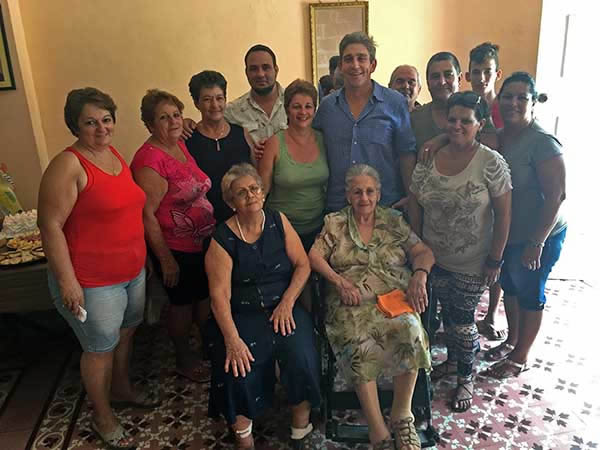
Late in the afternoon, Orlando García, a writer and historian, and an old friend, invited us to meet with writers and musicians at the Cienfuegos branch of the UNEAC (the Writers and Artists Union). It was the night of Candelario Alvarado’s peña, which he calls “Escritrova,” because it combines writing and trova music. We shared poems in between the cortinas musicales, everyone participating, and gathering in a more intimate circle under the rooftop when it began to rain.
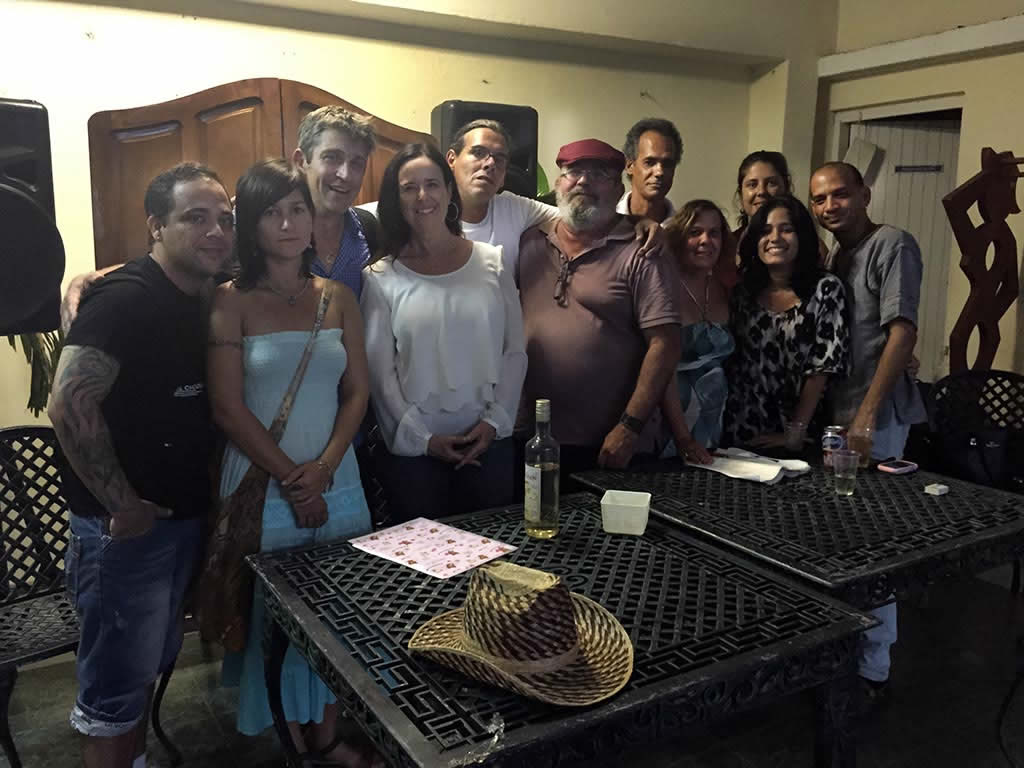
In the evening we hung out with several of Richard’s cousins on El Muelle, by the dock in Cienfuegos, and we talked about the future and what might come to pass with the reopening of diplomatic relations between Cuba and the United States. Will the Americans take over again, we wondered? One of Richard’s cousins very confidently replied, “Eso no va a pasar aquí. Olvídate de eso” (That won’t happen here. Forget about that). She, like so many others, seems certain that Cubans will know how to hold on to their independent and rebellious spirit into the future.
We went on to Matanzas, where famed book artist Rolando Estévez, a longtime friend, now runs an independent imprint called El Fortín. Estévez invited us to participate in an afternoon gathering of music, literature, dance, and art held at the historic Pharmaceutical Museum, a jewel of architectural preservation. He himself offered a dramatic performance of Dulce María Loynaz’s beautifully wrenching poem, “Eternity,” with its lines, “For you infinity or nothing,” bringing many of us to tears. (The poem is at the end of this letter.)
There were more tears to come on the journey back to Havana as a phone call led our driver Eduardo to stop along the highway to receive a message from his former wife’s eighteen-year-old son. The ex-wife had left the previous day for Canada, with plans to immigrate, without telling a soul. Eduardo was beyond hurt. He tried to hold back the tears, but couldn’t, and it was all we could do not to cry with him as we drove into the city, passing the Malecón, Havana’s famous sea wall promenade, desperately holding back the great force of the ocean.
Our last night we went to Café Madrigal, opened two years ago by Rafael Rosales, a filmmaker, who has filled the high-ceilinged space with massive art works, and ancient typewriters and projectors, and turned the bidet into a pot for his plants. With us was another longtime friend, visual artist Rocío García, who studied art for seven years on a scholarship in St Petersburg, back when it used to be called Leningrad. It so happened that one of Rocío’s friends from Russia was visiting and over vodka and frituras de malanga we talked about pessimistic hopes for the future, Rocío translating from Spanish into Russian. Only in Cuba, we thought, could so many languages, cultures, geopolitics intersect in such an easygoing way.
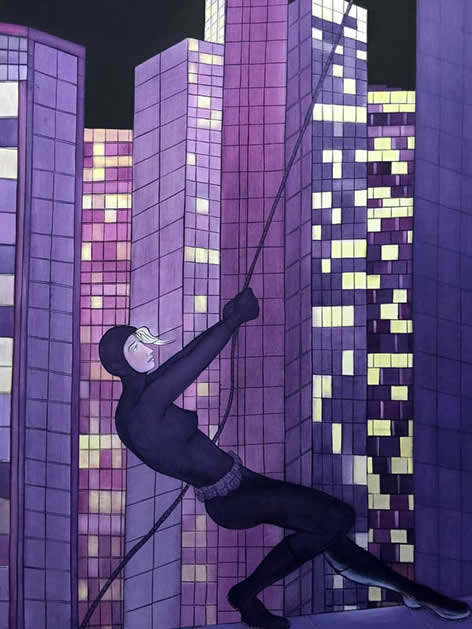
By Rocío García
The flight back to Miami was delayed five hours and we’d gotten there three hours early for our flight, as requested by the airline, so we had a long wait in limbo before departing Cuba. Richard needed to smoke a cigarette. Something unexpected had happened in Cuba—it wasn’t possible to smoke in the airport anymore! But along with others, including airport personnel, Richard snuck in a quick smoke in the airport bathroom. Again, only in Cuba.
We’ve returned inspired by this trip. We saw so many possibilities for bridges among writers, artists, musicians, and Cubans of all walks of life. We’ll be sharing news of these and other stories in upcoming blogs. We look forward to your responses and truly feel grateful to all of you who are fellow bridge-builders.
Gracias y abrazos,
Ruth
Dulce María Loynaz
From Versos, 1920-1938 (1938)
ETERNITY
I want my favors not to disappear, but to live and last, if possible, all my friend’s life.
SENECA.
I’ve roses in my garden.
To you I will not give
my roses, for tomorrow—
tomorrow you’ll have none.
I’ve songbirds in my garden,
chanting crystal songs:
I won’t give you them, for they
have wings to fly away.
In my garden, honey bees
are crafting well-wrought combs:
the sweetness of a moment—
I won’t give that to you!
For you, infinity
or nothing; what lasts all time
or this unspoken sadness
that you can’t understand.
The unnamed sadness of
having naught to give
to one whose own looks carry
hints of eternity.
Leave, then. Leave this garden.
Do not touch this rose:
Things that death will carry off
are not to be touched.
Translated from the Spanish by David Frye




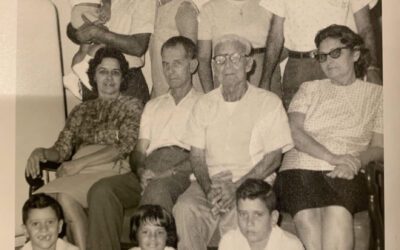
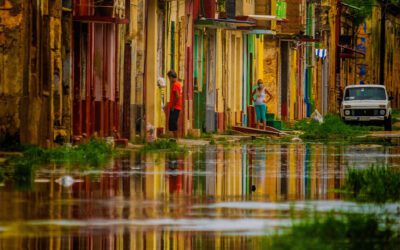
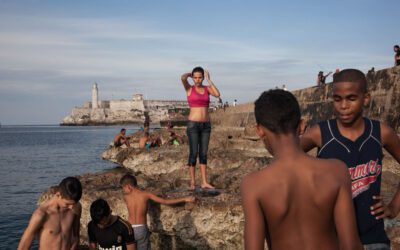
What a wonderful visit! So promising.
Thank you so much for sharing these experiences, photographs, and poetry. I am delighted that Richard feels he has two homes now. I know his search will continue.
Gracias, Ruth and Richard, por esta iniciativa extraordinaria… y tan hermosamente llevada a cabo. Este espacio para compartir recuerdos, emociones, sentimientos, creatividad y amistades debe permitirnos construir esperanza a pesar de todos los pesares. Gracias.
Disfrute cada momento del viaje gracias a la lucida descripcion y a las similitudes con mis experiencias en viajes recientes a Cuba. Y gracias por el poema de Dulce Maria.
Enhorabuena. Espero leer muchas entradas mas.
En solidaridad y amistad
Alma Flor Ada
Very inspirational. I was very touched reading your article. You were so descriptive that I felt I was along for the journey. Although I left Cuba when I was 7 yrs old ( 44 yrs ago ) I have such a passion and love for the country and the people. Thank you for reminding me of the beauty that our island possesses.
Thank you for sharing your trip with us. Please print the poem in its original Spanish form.
Hi Cari, the whole blog is available in Spanish. On the sidebar you’ll see tabs for the English and Spanish versions. Thanks so much for reading!
Thank you so much for sharing, I look forward to the next post
You as well as Richard are amazing.
Always sending love &.light ..
Sonia
oxo
son muy valientes,se meercen el reconocimiento internacional por su ardua labor contra el regimen de los castros,pero el mundo civilizado,esta enfrascado en otras cosas,y siempre los derechos humanos van hacer mancillados por los poderes economicos de los paises en desarrollo,a cuba la salvan los cubanos,como, no se,la rebelion en masa contra la injusticia,y como dice el himno de la patria,Al combate corred bayameses,que la patria os comtempla orgullosa,a no dejar que el gobierno de espana,siga apoyando la dictadura,y sacarlos de cuba siempre,una vez mas,como hicieron los patriotas de Bayameses en su epoca,ya saben como.
I feel the preciousness of my gay culture as the world shifts to inclusion. What lies before me is unknown, perhaps unwelcome. I loved the private separateness that I can’t describe to new community. They’ll never know the rich culture we lived. I’m reluctant to open those doors to change.
Ruth, Ricardo: gracias por la carta con la información de su reciente y emotivo viaje a Cuba. Me encantan las fotografías de las familias, de los artistas, de los escritores, y de ustedes. !Qué bello el poema de Dulce María! Muy a propósito de su aventura, allá donde subsiste el recuerdo como subsisten igualmente las memorias aquí.
No hay diferencia entre cubanos. Es algo que se debe considerar seriamente al comenzar a construir puentes.
Creo que el arte es un aliado, no tan sólo un vehículo, del acercamiento que se nos viene encima.
Felicidades y sigan construyendo puentes.
roberto g. brito santaló
(Salí de Cuba a principios de 1962, a los quince años.)
Sounds so wonderful. So glad you got to do this. I really envy you.
I cannot describe how I feel after Reading your cronicle. I have tears and emotions. I am Cuban and had bad experiences because I was jailed as part of a Human Rights Group I barely knew it. I could have hate in my heart but I can. Cuba is my homeland and I don.t doubt you had a great time and there are a lot of great people in Cuba too. I felt I was traveling with you. I was with this poet and his family, the Friends, the writers. I enjoyed. What to say.
querida Ruth,
qué conmovedora la crónica. Conseguís conmoverme hondamente. Aunque no tengo nada que ver personalmente con Cuba, es parte de estas movidas de desarraigos y expulsiones que nos han llevado de aquí para allá. A los judíos. Pero no solamente. A los expulsados. A los desplazados. A los refugiados. Para todos estos millones y millones de seres, tu regreso es parte de un sueño compartido. Qué sanador que lo puedas estar haciendo. Gracias por ponerlo en palabras y por permitirme subirme, un ratito, a ese puente. Con cariño, Diana
Thank you for this blog, and for the initiative. I am an Indian who lived in the US and now I am in London. I can resonate so much with the scenes in Cuba, and the experiences of Cubans. I have read Margerita Engle’s books and loved them all. Something about Cuba attracts me to it. I wish you all the very best!
Lovely, beautiful blog, i would love to go to Cuba one day. I am so interested in everyihing. Please keep this blog open to try and inform Americans about the true Cuba, and relations with America l. God bless.
GRACIAS por la bella iniciativa y el poema. Conozen la cancion ” Flores,flores, ahi vienen Las Jardineras, vienen regando flores”? Esta cancion se las mando a ustedes.”puentes, puentes, ahi vienen los poetas, vienen construyendo puentes!”
¡Bellísima historia, Ruth! Gracias por compartirla con nosotros. Nos llevaste contigo en tu viaje a Cuba, compartimos sus emociones, el encuentro con parientes y amigos, escritores y artistas.
Favor publicar el poema de Dulce María Loynaz en español.
El blog es maravilloso.
This project nurtures the garden of creativity – that transcends political lines, language differences, and so many other separations we impose on ourselves – you’ve created a safe space for exploration, growth, curiosity and hope. May all who enter be touched by something beautiful, and be inspired to leave words from the heart. I look forward to watching the ‘mosaic’ appear and hope there become ways to participate (maybe a side project built with offered words and ideas.)
Blessings to those with hearts unblind!
Lindas palabras con tantos cuentos… Fue una vida bella, Llena de los colores de Mandavillas y el olor de los Tamaleros… Siempre feliz cerca de las playas de Miramar y alrededor a nuestras familias…con las conversaciones en Espanol y Judio….~ ???
Gracias por todos los puentes que a lo largo de todo el tiempo han construido y han inspirado a otros a colaborar en su construcción.
Ya hablaremos más de un proyecto en marcha.
Muchas gracias por este blog,
un abrazo desde La Habana,
Esther
I felt that this was a very interesting and powerful piece in the sense that it promotes a lot of positivity and hope for a lot of people. After leaving and seeing all the possibilities of bridges amongst various shows how there are multiple people working together at the same goal, which is an inspiring pieces. It shows how these bridges are being built allowing for people to relate and connect with one another. Within this story, I also liked the use of all the pictures and how they seemed to relate with each moment that was being talked about. For me, that seemed to give me an even better understanding of the trip as a whole, and the experiences that went along with it.